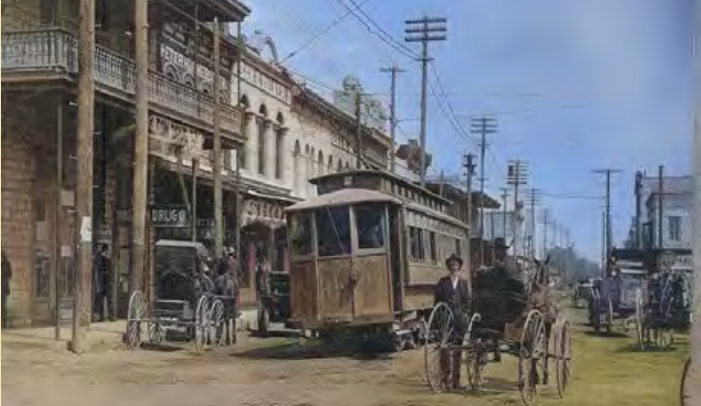Belton Celebrates 175 Years of Colorful History
March 13, 2025

By Daniel Moctezuma
Belton Journal
This year marks the 175th anniversary of the City of Belton and Bell County. Located on Nolan Creek at the center of the county, Belton was first settled in the late 1840s as Nolan Springs. When Bell County was established in 1850, the city was renamed Nolanville.
In August 1850, the town was laid out in blocks and streets, with a courthouse square at its center, as described by longtime librarian Lena Armstrong. The name was changed from Nolanville to Belton in 1851. Initially the only town in the county, Belton served as a key stop for pioneers heading west.
Soon after lots were sold, businesses and a post office were established, and mail arrived by horseback. But, a stagecoach route that started in Tennessee and ended in Brownsville made Belton a weekly stopping point. That brought more business and people to the county seat.
A two-story log jail was erected in 1853, and it was quickly followed by a school, hotel, church, saloons, stores and other businesses. Most were log buildings or pole shacks, but as more people arrived the buildings began to be permanently constructed
A log courthouse was built in 1852, followed by a limestone courthouse in 1859. By 1860, Belton had become the largest town in the county, with a population of 300.
The city has a great deal of history, and over this year, The Belton Journal will highlight a few of its treasures with pictorial stories. In the meantime, here are a few highlights about our great city and county:
Despite some pro-Union sentiment during the secession crisis, the county ultimately voted for secession. After the Civil War, Belton faced violence and lawlessness, marked by several lynchings. The town began to recover in the late 1860s and grew as a business center, especially for agriculture, with the establishment of the first bank in 1867 and the rise of the Belton Woman’s Commonwealth.
Although a fire in 1879 destroyed much of the central business district, the town quickly rebuilt and by the mid-1880s had a population of 4,000, daily mail service, three newspapers, and several schools and banks. Belton developed into a processing and shipping center for cotton, with the first cottonseed oil mill opening in 1879.
The arrival of the Gulf, Colorado and Santa Fe Railroad in the early 1880s brought growth, but Temple, established eight miles to the northeast, quickly surpassed Belton in size. Nonetheless, Belton retained its status as a county seat and continued to thrive, particularly after an electric interurban line connected the two towns in 1905.
Andrew Carnegie established over 2,500 free public libraries worldwide, including 300 in Texas. One such library fulfilled the dream of the Women’s Wednesday Club, a literary organization founded in Belton in 1898 with 25 members who aimed to create a public library for the community. In collaboration with the Century Club, the Wednesday Club secured a $10,000 donation from Carnegie in 1903 to build a library, provided the city would obtain a lot and maintain it. Local residents raised an additional $1,500 for a lot on Main Street. The completed library, a two-story building with 6,220 square feet, opened on May 15, 1905. However, it closed two months later due to funding issues, struggling for the next 25 years. By 1933, the library became a city department. After outgrowing its original location in the 1970s, a new building was constructed at 301 East First Avenue in 1974, while the original library now houses the Bell County Museum.
Significant developments included the establishment of a public water system in the mid-1880s, a fire department in 1884, and the introduction of electricity in 1889. In 1885, Baylor Female College moved to Belton, which later became the University of Mary Hardin Baylor
A cotton yarn factory opened in 1901, and the population reached 3,700 by 1904.
Belton was dependent on the cotton industry from the 1880s to the 1920s. As a result, there was a need for a yarn mill to complement the cotton trade and to provide facilities for cotton processing locally. Cotton bought on the streets of Belton was manufactured into cloth and yarn.
The Belton Yarn Mill was a two-story building built by a group of businessmen in 1900. The mill was erected at a cost of $25,000. The fuel used by the Belton mill was lignite, shipped from Rockdale in Milam County. The mill began operation in October 1901 and originally had 3,100 spindles and 100 looms. At its peak, the mill consumed from 2000 to 2200 bales of cotton annually.
The mill employed approximately 112 people and had an annual payroll of about $30,000. Most of the employees were residents of Bell County; some from poor families and some from tenant farms. The tenant farmers worked as semi-annual hands, coming to town twice a year in between cotton planting and cotton harvesting. The mill owned 25 cottages to house employees.
After the Panic of 1907, the mill closed and stood empty for nine years. It was eventually reopened and continued to operate until the late 1920s or early 1930s when the cotton industry in the county collapsed.
The building was sold and functioned as a school and library furniture manufacturer until a fire ravaged the 300,000-square-foot complex of buildings shared by Indeco Sales and Maco Manufacturing.
In its early history, Belton experienced several disastrous fires, and as a result, local residents were determined to build a waterworks system that would provide adequate protection.
After consulting with engineers from waterworks companies, Belton designed a complete water system including water mains in the business district, a 50-foot standpipe north of town, and a double pumping plant at the Leon River, all costing $41,500 in bonds. The first municipal water system was completed and delivered on July 1, 1884.
The original standpipe, an iron structure near 10th Avenue, was raised by 35 feet years later. Unfortunately, it deteriorated and burst in October 1909, flooding Main Street. The site was then abandoned in favor of a new standpipe south of town.
The Belton standpipe was built on Denison’s Hill, standing 75 feet high and 24 feet wide, to provide water to residents south of Nolan’s Creek.
In August 1928, the standpipe became a topic of concern when residents noticed small water bugs in their faucets. Rumors circulated about dangerous creatures allegedly crawling over it. The State Department of Health analyzed the water and found it safe, but fears persisted.
To address the concerns, the City Council moved up the planned cleaning of the standpipe. A raft with a dozen men was placed inside, and as water was drained, the raft sank. The Belton Journal noted that the men’s efforts revealed only a few inches of sand, contrary to the expected debris.
By the mid-1960s, the standpipe was insufficient for the city’s needs, especially during summer, leading to higher fire insurance costs. The City Council proposed a $600,000 bond for additional storage, and in 1975, the standpipe was retired. City Manager George Ferrell reported leaks made repairs impractical, so the structure was drained and abandoned after a new 100,000-gallon overhead tank was completed.
Ultimately, it was decided to preserve the standpipe. Added to the National Register of Historic Places in 1990, it is now undergoing renovation and will open as a community park this year.
In December 1913, downtown Belton flooded, but the town thrived until the Great Depression, which caused many businesses to close. The population peaked at 6,500 in 1928 but dropped to 3,779 in 1931. The economy began to recover in the early 1940s with the development of nearby Camp Hood later named Fort Hood and now Fort Cavazos.
Belton has experienced a lot of growth since the 1970s and now sits at 25,171 according to the 2023 estimate census and Bell County now has over 450,000 residents.
At the end of this month, on March 29-30, the City of Belton will officially celebrate this 175th birthday. Go to page B10 or seebelton.com for details.
-

Slide title
Kwik Kar
Button -

Slide title
Standards Home Health
Button 
Slide title
VFW 4008
Button-

Slide title
DON RINGLER TOYOTA
Button -

Slide title
CAROTHERS EXECUTIVE HOMES
Button -

Slide title
DON RINGLER CHEVROLET
Button 
Slide title
ALTON THIELE
Button
Slide title
BELL COUNTY FLOORING
Button-

Slide title
DOUBLE T CONSTRUCTION
Button -

Slide title
DOUBLE T CONSTRUCTION
Button
